The Juno spacecraft made its eighth flyby of the planet Jupiter on Tuesday. This time it passed for the first time over the Great Red Spot, Jupiter's giant storm whose length reaches about 16,000 km - and the photographs are spectacular.
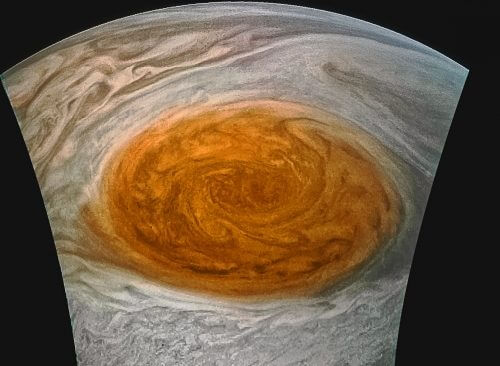
NASA's research probe Juno performed yesterday (Tuesday morning, according to Israel time) will fly another near Jupiter, the largest planet in the solar system. the probe entered orbit around him A little over a year ago, on July 4, 2016. This is the eighth total flyby of the spacecraft near Jupiter, which orbits it inA very long elliptical track which lasted 53 days.
During the flight, the spacecraft reached a distance of only 3,500 km above the cloud cover of the gas giant. 11 minutes later, the spacecraft passed, for the first time, over the Great Red Spot, at a distance of 9,000 km - and thus studied the giant storm closer than any other spacecraft in history.
"For generations people from all over the world and from all walks of life have marveled at the Great Red Spot," said Scott Bolton, Juno's principal investigator from the Southwest Research Center in San Antonio, Texas. "Now we can finally see what the storm looks like up close."
The Great Red Spot is an anticyclonic storm whose length from east to west reaches about 16,000 km, with winds capable of reaching a peak speed of about 650 km/h. The storm began to shrink in the modern era, And its size today is half of that measured at the start of its measurements. Despite the shrinkage, it is still so large that the entire Earth can fit inside it.
The giant storm has existed for at least 187 years, since regular observations of it began in 1830. Opinions differ as to the first sighting of the storm, and astronomer Giovanni Cassini may have observed it as early as 1665. If this is true, then its age is at least, if not more, 350 years. Researchers hypothesize that one of the reasons for the storm's longevity is the lack of solid ground that creates friction (like on Earth).
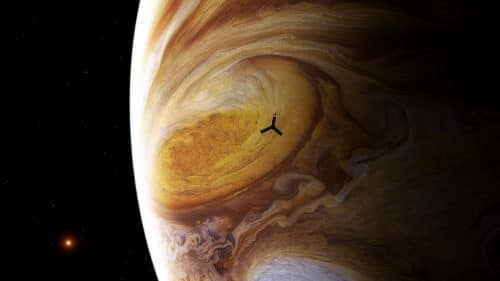
Although the storm has been studied for so long, from distant observations by telescopes on Earth and in space and close observations by the Voyager spacecraft in the 70s, Galileo in the 90s and Cassini in 2000, the dynamics of the storm and how it formed are still not completely clear to researchers. Even the source of the storm's red hue is unclear, although according to One of the hypotheses raised, it is formed as a result of the reaction of certain substances, such as ammonium hydrosulfide, with cosmic radiation and the sun's UV radiation.
NASA published yesterday the The raw data from the spacecraft's single visible light camera, JunoCam, and anyone can download and process them independently, as part of a program for public participation in the mission.
Although the new close-up photographs will help in the study of the giant and mysterious spot, the main part will be carried out by the other scientific instruments of the spacecraft. These instruments, such as a radiometer that measures the microwave radiation emitted by Jupiter, are able to penetrate through the storm's outer cloud layer, and will provide a first glimpse into its roots in the deeper layers of Jupiter's atmosphere.
"For hundreds of years scientists have observed, wondered and theorized about Jupiter's Great Red Spot," said Scott Bolton. “We now have the best images of this iconic storm. It will take us some time to analyze all the information, not only from JunoCam, but also from Juno's eight scientific instruments, to shed new light on the past, present and future of the Great Red Spot."
See more on the subject on the science website:
- A wonderful new world: the Juno spacecraft reveals Jupiter as we have never known it
- Is Jupiter's Great Spot causing its upper atmosphere to warm?
- The Great Red Spot on Jupiter is shrinking
Here are some of Juno's new photos:
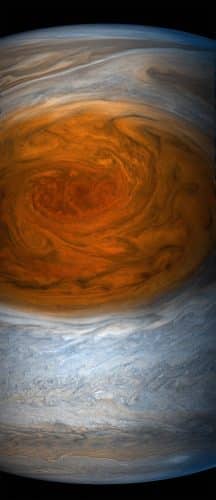
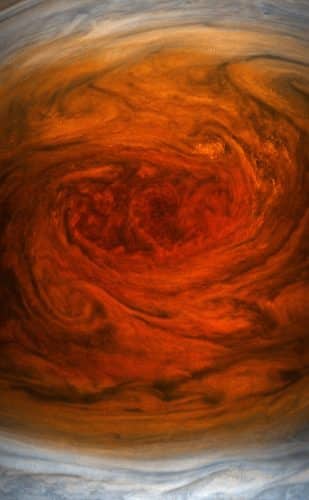
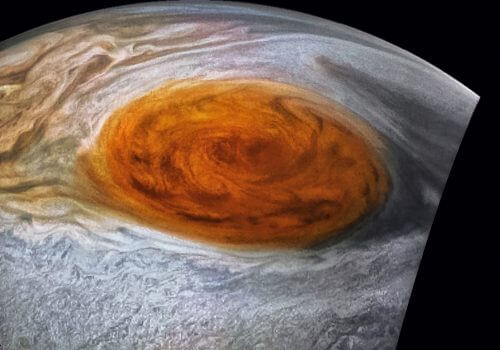
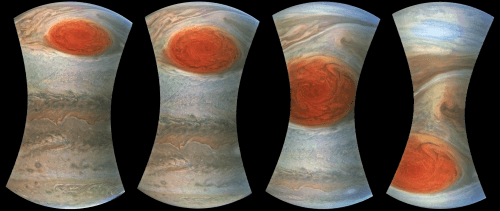

11 תגובות
Yosef - What is the connection between everything you wrote here and this "egg of the spring" that was photographed on the planet Jupiter?
A review of Miriam Mizarkani's biography
https://en.wikipedia.org/wiki/Maryam_Mirzakhani
It turns out that she also dealt with Teichmuller theory.
Oswald Teichmüller, a mathematician whose influence of his ideas resonates now, enlisted in the Wehrmacht as part of compulsory service in 1939 and was killed in his service in 1943 and it's a shame. 77 years after 1939, long after he could have won recognition, his theory is now considered a cornerstone of abstract algebra, and differential geometry. Pure mathematics comes at a high price.
Footnote: today the Iranian Miriam Merzani, the first woman in history to win the Fields Medal, which is the Nobel Prize in Mathematics, was solved. It is appropriate to mention her as well. If we examine who were her supervisors in the PhD and with whom she developed the work for which she was awarded the Fields Medal - a Jew. Iranians have at least 2 more big ones. Professor of string theory physics Nimer-Arkani-Hamed from Princeton: proved that the dimensions of space can be derived from pure energy, and recently developed a mathematical structure to simplify calculations in string theory, a geometric structure of space-time that has in one partition past-present-future like a black hole. Vishnu is a gifted musician, he was also educated by Jewish musicians. Sohail Nosayri.
Shinichi's new theory - today considered by a considerable number of researchers - the greatest breakthrough in mathematics in decades. In the past, popular articles were written along the lines of "Is he right". Today, after 3 conferences where 20 people gave feedback to the articles, and actually learned from Sinichi what he wanted to explain, and it is true that 4 research groups are taking his work more seriously and translating it to laymen: to number theory expert professors.
It can be said, in my estimation only, that he is probably right, even if his building blocks are not all along the way correct.
Sinichi is already famous from the past, and proved the Grothendieck conjecture (1/2 Jewish) on an abelian geometry on hyperbolic curves over number fields. Now the huge IUT theory on which he worked for 20 years is being broken down into minor theories so that mathematics professors are able and they are already able to understand them: mono-abelian geometry, Hodge-Arklov theory, Teichmüller theory (killed in the Wehrmacht army in World War 2) the p-adic. The frobenioids theory, and the etale theta-function theory. The beautiful simulation created by Etienne Percot, a former professor from the University of Nottingham, where Ivan Pesenko comes from - makes order by connecting the theories.
I suppose there will be mathematicians who will disagree with what I say, but in my opinion, or this is the biggest scam at the present time, I believe it to be true. Muzouchiki deserves when they finish the feedback on his theory - in my opinion recognition.
Another reference in clear language about IUT innovations
Ivan Pesenko from the University of Nottingham
http://inference-review.com/article/fukugen
It is a bit strange that, just as Moshe needed Aaron to translate his words into the language of the majority, if Moshe had existed,
Shinichi Mozuchiki who continues to type the IUT articles, and writes them in a superior configuration. In my opinion, the theory can only be understood from Pesenko. This is what happened with Perlman's papers proving the Poincaré hypothesis. Perlman refused to accept the prize money he deserved, and stopped teaching at the university. That's a shame.
Qualify my words. Everything in my opinion. In the article, even the articles were not published in the newspaper. Because there is no committee that has ruled: the theory is correct. Proving the ABC conjecture is correct. But I think at least 4 research groups are dealing with it. There is another possibility and that is that there will be corrections to the theory. Mega corrections. Because Shinichi introduced hundreds of small clarifications in the 2017 versions of the 4 articles from 2012, and also wrote a relatively new article called A Panoramic Overview of Inter-universal Teichm¨uller
Theory in the scope of 45 pages. Modest in relation to the 500 pages he has already written in the 4 elementary articles.
I met a lot on the net who claimed that Hogg is making up nonsense. It bothered me that I couldn't decide who was right. recently,
From a partial understanding of the structure, I estimate that he is right.
There aren't many who dare like Shinichi Mozuchiki who composes mathematics that deals with transitions between abstract algebras. In a field that you are the only one involved in. This is the difference between religion and science. In religion they would have persecuted him for this. In science it is allowed to make a breakthrough. There is a risk.
The scientist does not publish innovations in mathematics.
The more I mine information about the inter-universal Teichmuler theory, the more it dawns on me that those who ascribe correctness to it are right, and those who think that Shinichi Mozuchiki wrote 500 pages of the Bible are wrong.
Whoever says that this is nonsense has not researched deeply enough, in my opinion. I was also a skeptic for two years. The amount of mathematicians who invested in animations to graphically explain the skeleton of the theory is too great, and the quality of their work is too good, and they are very good. Today, 5 years after its publication, the theory is considered the greatest revolution in mathematics in decades. I was surprised to see how many Jewish and Israeli mathematics professors are in the best universities in the world. They are among the Revoires. Although in the top 4 Japanese - Hoshi, Russian - Pasenko.
Ivan Pesenko summed up the theory best, and it is understandable from here why it is difficult to understand and it will take at least a decade to start publishing it. Although Mozuchiki's 4 articles were not published, they are already referenced. They are in a similar situation to Perlman's papers on the Poincaré hypothesis.
In my opinion, this is not a myth, but the real thing. The rest of the world of mathematics deals with breakthroughs within the existing algebras. Here it is a step change, as there is between assembler and C, to C++, to aspect-oriented programming, to neuron programming. Passages of stairs.
Mozuchiki created a new abstract word in algebra more than the abstract algebras that already exist today. A metatheory in which abstract algebras are substructures within it.
That is why the language is so difficult to understand, and historians point out that such methods of proof have never been seen in the world. But surely they are not nonsense. It is estimated that Mozuchiki, who is a famous mathematician since before, worked on the theory for 20 years.
The best work from which to understand the theory is by Ivan Pesenko
https://www.maths.nottingham.ac.uk/personal/ibf/notesoniut.pdf
Summarizes the 12 elements of the new theory.
Amazing animations of the new algebraic structures.
https://www.maths.nottingham.ac.uk/personal/ibf/files/iut.anima.html
https://www.maths.nottingham.ac.uk/personal/ibf/files/symcor.iut.html
Click on the links and wait for the videos to download.
The author himself has infinite patience for questions. already 5 years. He probably realized that this is his life's mission, and he writes articles
It is still too early to discuss the implications of the theory on how research is conducted. Just in terms of science, a mathematician (2012) founded a new superstructure in algebra. We believe that it will have an effect. Evidence for this will probably be found in headquarters.
Actually Wikipedia refers to articles about the theory as best as possible, except for their request for a contribution.
It's almost unbelievable that there are people who are much smarter than us. Some of them are insane in our terms, but some are. But like a prophet, they need priests - mathematicians of the first rank, who will explain their work.
I didn't understand anything from Shinichi's work. He warned that one should read two or three years' worth of material before accessing his 4 articles. From Pesenko's work, Wikipedia, and the animations, I understood that this was a serious theory and not nonsense, I began to understand what the man wanted to say. He literally invented new mathematics, an extra layer, to his proofs.
It is estimated without exaggeration that Shinichi IUT's theory solves 100 famous conjectures. For example the ABC hypothesis, and the strong Shapiro hypothesis. No less than 100 unsolved sentences in mathematics.
I don't understand either, there are so many more important things that can be done in space.
In general, I don't understand what the point of this mission was, solar panels made of glumen, knowing that the chances are low that the probe will work properly in minimal sunlight.
And if that's not megalomaniac enough, the plan to crash the probe into Jupiter.
It's starting to feel like someone at NASA is bored, and all they want to do is take pretty pictures to get funding.
I would like to see space mining in my lifetime.
Very beautiful - only I don't really understand what is to be learned from this whirlwind of gases that so much effort and money has been poured into.
There was no money for a round camera?